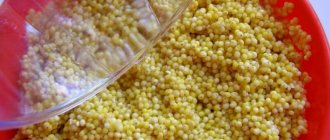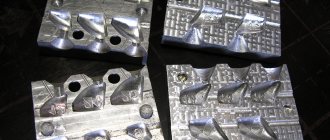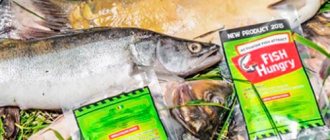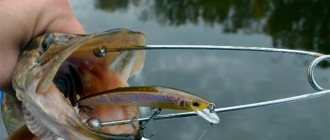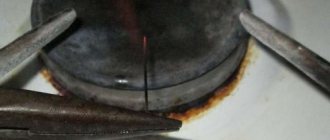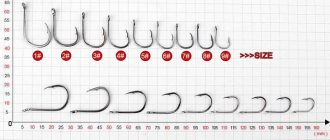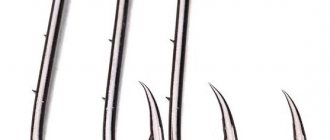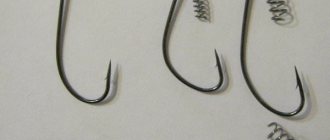Equipment
13.08.201813.08.2018
Spread the love
Most modern fishermen have long since stopped asking the question of how to make a hook - why waste time on homemade products of dubious quality when any fishing store offers an assortment to suit every taste and budget? Even in the best case, homemade hooks will be superior in quality to only the cheapest Chinese ones. It is simply impossible to reach the level of the best Japanese (“Decoy”, “Gamakatsu”, “OWNER”) or English (“Preston”, “Drennan”, and others) manufacturers at home. Do-it-yourself fishing hooks are most often made by those fishermen for whom this is another hobby, as well as by those who, due to the specificity of their favorite fishing method, find it difficult to find suitable products even among the huge variety in fishing stores. Other fishermen are primarily interested in sharpening hooks, and not making them.
Heat treatment of steel
The main material in the production of fishing hooks is steel. To perform heat treatment, steel must be heated and then quickly cooled in water or oil. This process is called "hardening". During this treatment, the properties of the steel will change.
Raw steel before heat treatment is easily subjected to various deformations (can be sawed, forged), but after treatment it acquires sufficient hardness, but remains brittle. Given this circumstance, it must be treated with abrasive materials.
The brittleness of steel after hardening will help reduce its tempering. This process is based on a method of heating already hardened steel to low temperatures with further cooling in oil or in the open air. The result of this procedure will be that the steel regains its original properties, that is, it will again become damp.
And lastly, annealing of tempered steel involves heating it to a temperature slightly lower than it was during quenching and cooling in air. As a result of this procedure, the steel will regain its original properties, that is, it will again become raw.
The time difference between these procedures cannot be more than 24 hours. The temperature used when tempering steel is always different (from 150 to 500 °C) and depends on the type of product produced from it.
When making hooks with your own hands, the material used can be sewing needles of any size or spring wire.
When carrying out heat treatment of hooks made independently, the following rules should be taken into account:
- When quenched using water at room temperature, the hardness of the steel is greater than when using oil.
- When the temperature of the steel reaches 330 °C, it will be viscous and suitable for making only a soft hook. To make a hard hook, hardening should be done in water, and for tempering, use a much lower temperature.
Heat treatment of steel is always carried out in a muffle furnace using a thermometer. But it is clear that there are no such stoves in homes and heat treatment can be carried out using a gas stove. Sewing needles are placed on a flat piece of steel and heated over a stove flame.
It is easy to determine its temperature by the heating color of the blank:
- dark brown color - temperature from 530 to 580 ° C;
- red-brown color - heating to 650 °C;
- cherry - up to 720 °C;
- crimson - heating to 770 °C;
- bright red - up to 870 °C;
- red - up to 900 °C;
- orange - up to 1050 °C;
- dark yellow - heating to 1150 °C;
- yellow-white - up to 1300 °C;
- white - heating to above 1350 °C.
It is impossible to anneal the spring like a needle due to the fact that it has a different design. It is annealed using a solution of salts: sodium chloride, sodium fluoride, aluminum fluoride, sodium chloride, calcium fluoride, sodium carbonate, etc.
When the material used to make the hooks is ready, you can begin making them. After the hook is ready, it should also be hardened.
But let’s return to the Finnish hook and the situation with the reliability of its ingestion by a predator.
I remember an episode that once happened on a forest lake, which has now become an organized reservoir. But then the lake was wild and rarely visited, in particular due to the fact that it was located in the restricted area of the aviation training ground. Often at night one could see planes passing over the lake, and then flashes flashed at a distant training ground, and soon a blast wave came.
Apparently, due to the lack of people in the lake, there were a lot of large pike. And she was perfectly caught on summer flyer baits. Moreover, there were often cases when seasoned pike pulled out powerful pine poles from the bottom of the lake, on which the girders were usually hung.
One day such a pike grabbed a baitfish, went into the grass and then mowed down a whole island of water lilies with a fishing line. The pike walked in circles and cut water lilies until it heard our boat. And here the pike showed what it was capable of... A powerful large fish began to jump out of the grass in “candles” and shake its head, like a ferocious shepherd dog, and finally got off the hook, as it seemed to us. But with her weight and jerks, she turned out her stomach along with the hook and sank to the bottom next to the boat. The father had to dive into the water and finish off the fugitive with a knife, and then lift her into the boat. Here it is, a Finnish hook...
Share with your friends!
Main types of offset printers
A hook that has a Z-shape with a bend in the fore-end at the top is called offset. This hook was first used in the USA at the beginning of the 20th century. Since then, it has been continuously improved for use in combination with other equipment. What motivates anglers when using an offset hook in fishing?
The big advantage of using them is:
- The hook allows you to use it for catching fish in dense thickets.
- It allows you to reliably attach any bait, while preventing it from slipping off the hook. This is convenient when fishing with heavy weights over long distances.
- Its shape allows it to easily penetrate the side of the prey's mouth.
- Allows you to firmly hold prey when fishing.
Offset hooks are divided into two types:
- Worm-shaped.
- Coolheads.
These two types are very different from each other. Their differences lie in the dissimilarity of the design and the type of bait used.
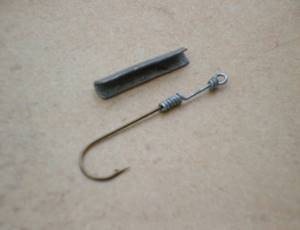
Large-faced offset baits are used to attach massive silicone baits. Moreover, the size of the hook itself is selected so that there is a reserve so that during the bite the bait does not slide down and at the same time the sting is exposed.
If a fisherman uses silicone worms as bait, and they have a thin body, then it will be rational to use worm offsets.
When using offset baits in fishing, most fishermen adhere to the rule that the width of the hook in the hook should always be about 2 times greater than the width of the bait itself.
The invention and the beginning of mass use of these hooks gave impetus to the creation of new types of baits and equipment.
Finnish hook on a girder
The Finnish hook consists only of bent spring wire in the form of sharp antennae extending to the side without stings. The hooks were used in fishing with Russian gear - flyers, made either from a dry fork of a bush or from a slingshot cut from plastic or organic glass. Ten meters of thick fishing line was wound around such a slingshot, a clasp was tied to attach a metal leash, and a small weight, the size of an olive sinker, was placed above it. A leash made of nichrome or other strong but soft wire was equipped with a Finnish hook.
The pole was stuck under the pole along the edge of the water grass, but care was taken to ensure that the bait did not cling to the water lilies and the pole itself. Usually the pole was long, about four to five meters, and stood inclined at an acute angle. And the live bait couldn’t get caught up in it.
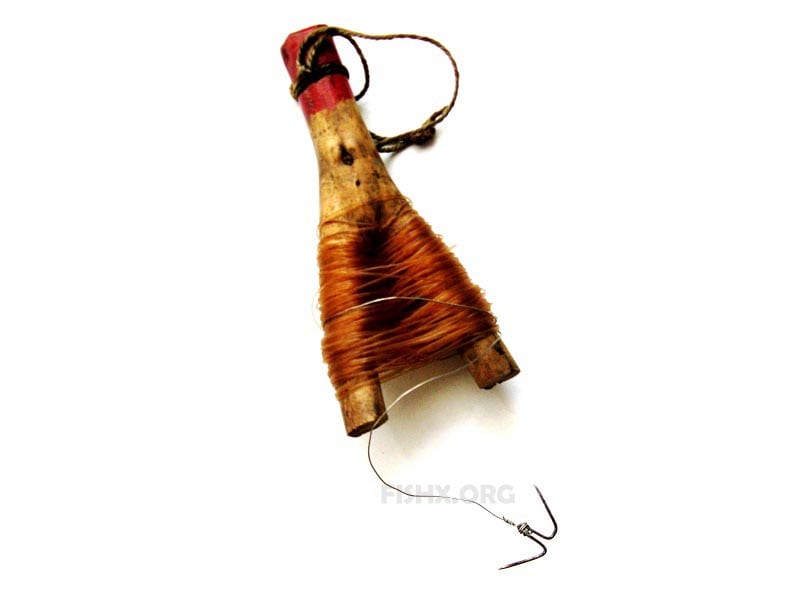
A leash was threaded through the gills of the live bait, and the Finnish hook then took up a position in the fish’s mouth, resembling a real mustache with its extending antennae. During the pike's grip and when the predator swallowed the bait, these antennae easily slipped along with the fish's head into the pike's throat and stomach. But on the way back, the antennae of the insidious Finnish hook no longer released the prey; they were a sharp spacer in the throat or stomach of the predator. There were no escapes from such hooks , except perhaps with the stomach turned inside out.
Of course, fishing and hunting are quite harsh trades and there is no place for muslin young ladies in this business. And it’s all about the genetic code embedded in the male breadwinner since ancient times, when the life of his family and community directly depended on the production of the primitive fisherman and hunter. Therefore, fishing not only for pleasure, but also for the sake of a full catch, is more justified than causing pain and shock to a living creature only to tickle one’s ambitions and empty entertainment on the “catch and release” principle. This is called humanism. But no one counted how many fish released later died. Humanists don't need this.
Manufacturing of miniature offset hooks
Unfortunately, specialized stores very rarely have miniature offset printers for sale, and if they do, their quality is often low.
During fishing in the summer, when the temperature is high, it is not possible to catch fish in reservoirs with a spinning rod. In such heat, she prefers to hide in dense thickets of aquatic vegetation or in places with flooded snags. It is in such places that you can hope for a good catch. For such fishing, miniature offset hooks are very useful.
Fishermen make these hooks from ordinary steel fishing hooks with a long shank. If the steel from which the hook is made is overheated, then the hook may break when bent. To avoid this problem, it is recommended to first hold it over the fire (for example, over a blowtorch or burner), but only the part that should be bent is held.
When fishing, the main load from its weight lies on the underframe, and a step that has a bend will not be able to straighten up.
Miniature offset hooks are perfectly combined with different baits and types of fishing.
It’s easy to make a pair of hooks yourself.Take a steel (or brass), preferably a tin-plated thin balalaika string, sold in music stores, 30 cents long. Hook No. 1 or 2 is attached to it using silk, if possible with a long shaft, and the spatula or ring is cut off. A second hook is wound to another similar wire, 4 sites long, in the same way. Then both wires are connected together and wrapped with the same silk and covered with oil varnish. In the absence of varnish, you can solder the wires with tin and then make a winding for strength.
The advantages of a pair hook over double hooks are so obvious that they should be tested when fishing for pike and perch with live bait. Live bait can be attached to paired hooks in different ways: hook the hooks on both sides of the ridge of the fish, pass the leash along the ridge, leaving the hooks on the side, thread the hooks through the ridge with their points to the sides, etc. Thanks to the mobility of the hooks, they can be rotated as desired, hidden sting, or expose - everything will depend on the fisherman himself.
With all methods of hooking on paired hooks, the pike has the full opportunity to fiddle with the bait, release it from its mouth and grab and swallow again, without the risk of pricking or injuring itself, as often happens when fishing on a double or anchor. In addition, in nine cases out of ten, the hook gets stuck in the throat, and not in the front of the mouth, and the prey ends up in the fisherman's basket.
It is only necessary to wind the short leash to the long one more carefully so that you can easily thread the leash all the way to the hooks under the skin of the live bait without any hindrance.
For pike anglers, we strongly recommend the new equipment, which everyone can modify in their own way, baiting bait in different ways to find the best one.
Art. Fisherman.
From the editor.
The proposed tackle for live bait should be widely tested when fishing with circles, as a more cultural way of fishing with live bait, and especially at our fishing base on Lake Senezh.
Article from 1929, writing style preserved.
How to eliminate frequent gathering of under-dusts.
Almost all anglers complain about the frequent gathering of pods. It often happens that out of 10 pruned bushes, it is possible to take no more than 5-6. What is the reason for this? I suffered for a long time with podusts, for a long time I examined the fishing rods of anglers who complained about frequent pods coming off, and as a result I achieved such a situation that out of 10 pods, on average, no more than one comes off.
I began to use hooks of fairly large sizes (No. 5, 6, 7), but thin steel with a sting that was extended somewhat forward and curled to the left side. Such a hook, well sharpened, captures more space in the mouth of the mouth, and no matter what position the hook is in the mouth, the mouth will still be hooked.
I had to change the rod. When you fish from a boat using a fly line, a long rod is very harmful. In order to put the line in your hands (when fishing without a reel), such a rod is extremely inconvenient; it brings the line to the surface of the water, where it is easier for it to unhook.
The rod should be no longer than 1.2 meters with a line length of 5.3-6.5 meters. With such a rod it is easy to give the underwater the first circle in the middle of the water, without releasing it to the top.
I usually use 6-hair cord, twisted like a “Dutch cord”. Such a line (with quite sufficient ability to stretch) is better than a knotted one, which stretches in excess, as a result of which the thick and strong throat of the undermouth rarely breaks through.
In conclusion, I should also note that you should not be afraid of breaking the lip under the mouth with a thin hook. After all, the lips of this fish are extremely hard.
Rybolov A. S. Khorobrikh. Article from 1929, writing style preserved.
Previous article All articles Next article
How to make a tee?
The treble hook is often used by fishermen when fishing with spinning rods, when catching large fish using live bait, or when equipping spoons and wobblers with them. You can make it yourself with single hooks.
To make a tee hook with your own hands, you need to prepare the following material:
- A small piece of rubber.
- Thin wire.
- Single hooks - 3 pcs.
- Solder.
The manufacturing technology of a fishing tee is quite simple:
- Make a hole in a piece of rubber with an awl or nail.
- Place single hooks completely into it so that they do not dangle and sit tightly.
- Copper wire is wound around the ears of the hooks, on their reverse side, which is then soldered.
- After soldering is completed, carefully remove the hooks from the rubber.
The triple hook is ready and can be used for its intended purpose.
Invisibility hook
An ordinary bobby pin is suitable as an affordable material for making a hook yourself. It can be used when catching large predatory fish.
During production, you should prepare the following tools:
- Pliers.
- Flat cutters
- File.
- A block of wood.
The process of making it is very simple. You should bend both ends of the bobby pin, measure the required length of the hook, and cut off all excess. Next, the ends of the invisible are sharpened with a file. As you can see, using a minimum of time and material, a strong hook will be ready.
Do-it-yourself sharpening of fishing hooks
Many fishermen, when purchasing hooks, are faced with the fact that they have poor sharpening. Before assembling the rod, these hooks must be sharpened. Often, an abrasive stone and a needle file are used for self-sharpening. But they can only sharpen the shank of the hook itself, and they will not be able to remove burrs.
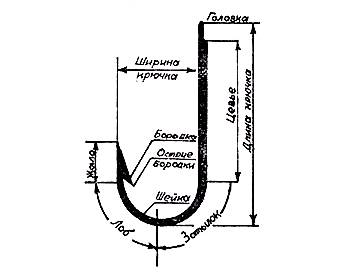
In addition, frequent use of a needle file and an abrasive stone for sharpening leads to rapid abrasion of the hook. In an attempt to avoid such problems, resourceful anglers have come up with a new procedure for sharpening hooks.
This procedure goes step by step like this:
- The abrasive bars are crushed with a hammer to a powdery state.
- The epoxy resin is heated and the prepared powder is gradually added to it.
- When the resin begins to thicken, any hardener is added to it.
- The thick mass obtained in this way is applied to a needle file.
- The smeared file is rolled out on a clean and hard surface.
A needle file prepared in this way can be used to sharpen hooks after two days. In order to sharpen a hook with such a needle file efficiently and without burrs, you need to insert the file into an electric drill and hold the hook with pliers.
The following methods are also suitable for quickly sharpening them at home:
- To make the hooks dull more slowly and not rust, you can dip them in a boiling solution of table salt for 5 minutes. To prepare such a solution you will need one tablespoon of salt and 50 grams of water.
- While observing personal safety precautions, you can also use a 30% nitric acid solution purchased at a pharmacy to improve sharpening. This acid eats away the top layer of metal and leaves a sharp edge.
- Many fishermen use diamond-coated needle files for sharpening, but only the hook tip needs to be sharpened from the inside.
- Fine-grit sandpaper is also great for sharpening.
Using the experience of many fishermen, we can say with confidence that hand-made fishing hooks will not be inferior in all their qualities to purchased ones and will take a minimum of time to make. Therefore, you can safely take them and use them for fishing.

